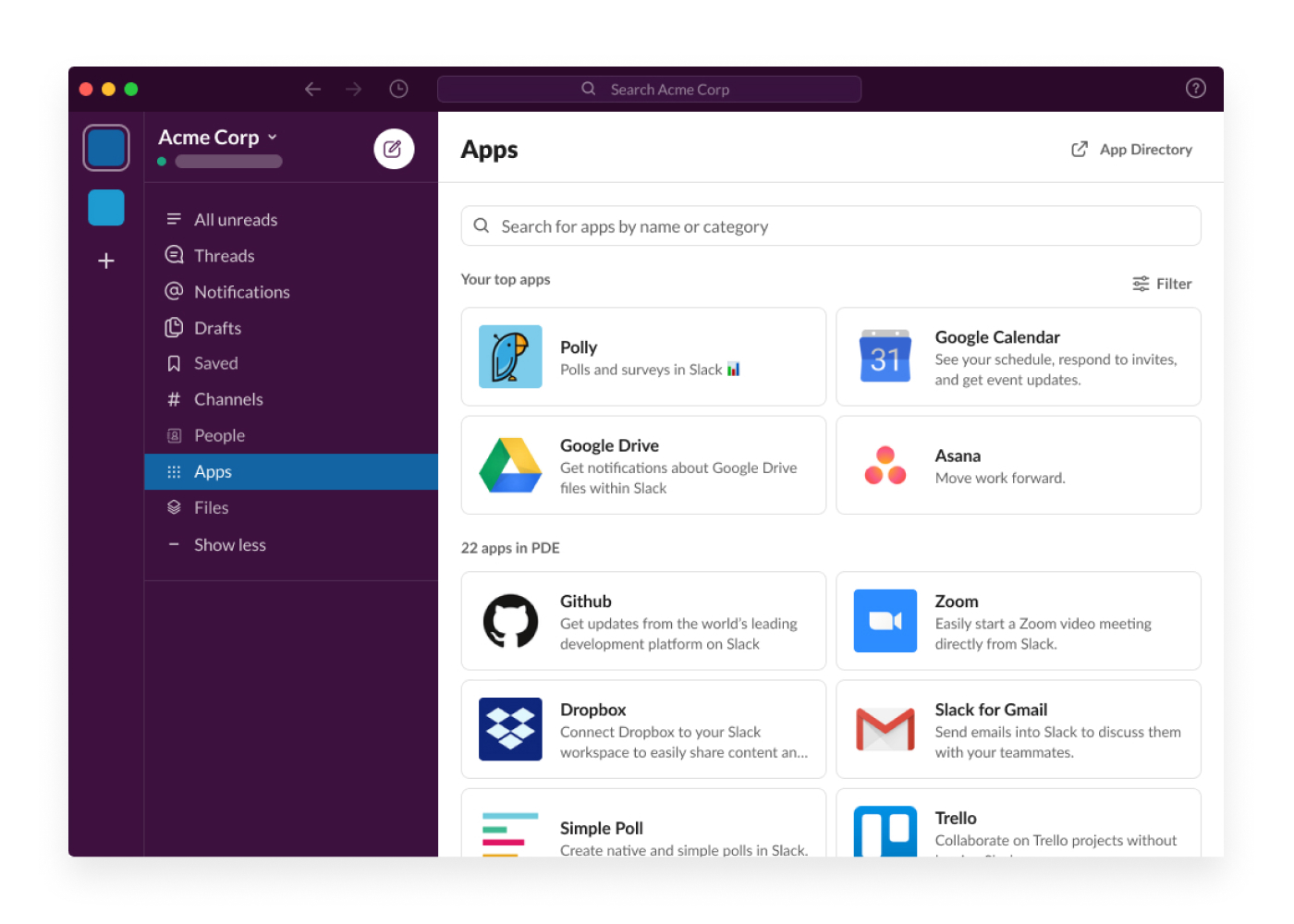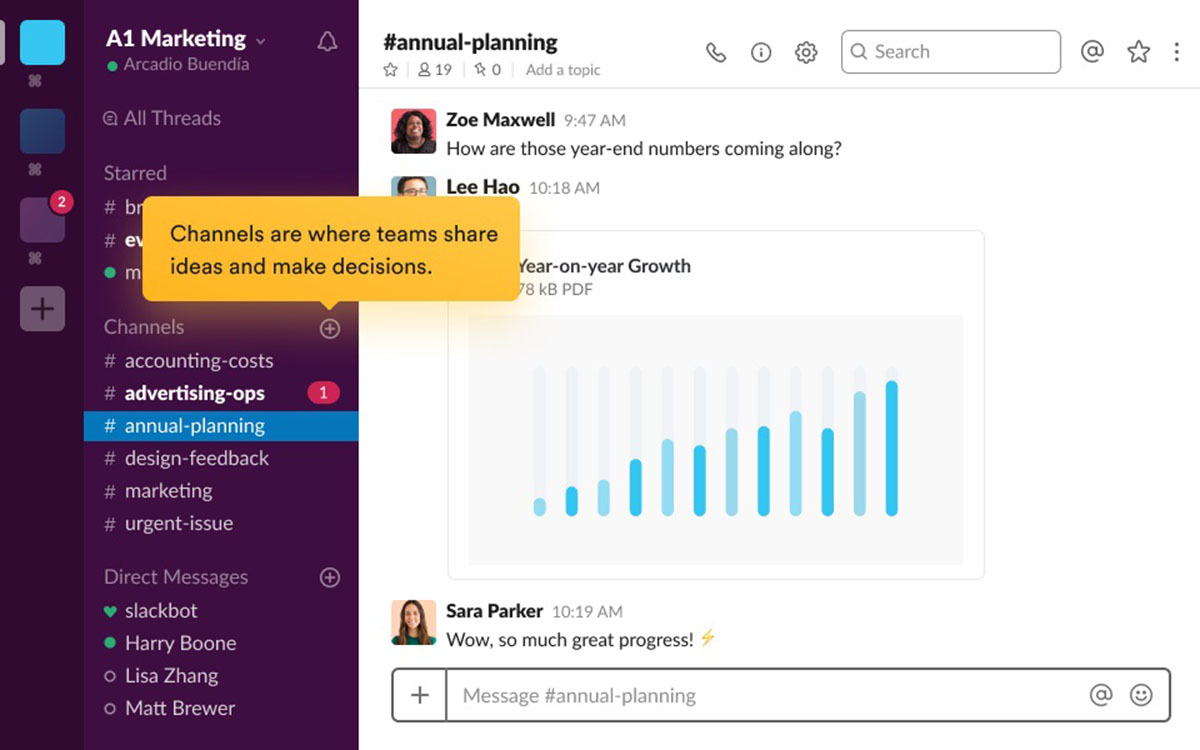Introduction
Slack is a powerful communication and collaboration tool that has revolutionized the way teams work together. With its intuitive interface and a wide range of features, Slack has become a go-to platform for teams across industries. One of the standout features that sets Slack apart is its Workflow functionality.
Workflow in Slack allows you to automate and streamline repetitive tasks, ensuring efficient communication and productivity within your team. From creating approval processes to managing ticketing systems and tracking progress, Workflow in Slack can simplify your team’s daily operations.
In this article, we will explore how to make the most of Workflow in Slack. You will learn how to set up Workflow, create custom workflows, assign steps to team members, track progress, automate actions, and integrate Workflow with other apps. By implementing these best practices, you can harness the power of Workflow in Slack to optimize your team’s workflow and drive productivity.
Whether you are a team lead looking to streamline processes or a team member wanting to simplify your daily tasks, Workflow in Slack has something to offer. So, let’s dive in and discover how to use this powerful feature to improve your team’s collaboration and effectiveness.
Setting Up Workflow in Slack
Before you can start using Workflow in Slack, you need to ensure that it is enabled for your workspace. To do this:
- Open Slack and go to your workspace.
- Click on the top left corner to open the menu.
- Select “Workflow Builder” from the list of options.
- If Workflow Builder is not visible, click on “More” and then select “Workflow Builder.”
- Click on the “Turn on Workflow Builder” button to enable it for your workspace.
Once Workflow Builder is enabled, you can start creating your own custom workflows to automate tasks. It’s important to note that Workflow Builder is available to all paid Slack users.
Workflow in Slack consists of a series of steps that guide users through a predetermined process. When setting up Workflow, you define the triggers, conditions, and actions for each step. These steps can be customized based on your team’s unique requirements.
To set up a new Workflow:
- Click the “+” icon next to “Workflows” in the Workflow Builder.
- Choose whether you want to start from scratch or use a template as a starting point.
If you choose to use a template, Slack offers a variety of pre-built workflows for common use cases such as approvals, content publishing, and employee onboarding. These templates can be customized to suit your specific needs.
If you prefer to start from scratch, you can define the steps of your Workflow from the ground up. This gives you complete flexibility to design a Workflow that aligns with your team’s unique processes and requirements.
With Workflow Builder, setting up and customizing your Workflow is a straightforward process. The user-friendly interface allows you to add steps, define triggers and conditions, and choose actions without needing advanced coding knowledge.
Once you have set up your Workflow, you can begin adding steps and customizing them to fit your team’s needs. In the next section, we will explore how to create and customize steps within a Workflow in Slack.
Creating a New Workflow
Creating a new Workflow in Slack allows you to automate and streamline your team’s processes. Whether it’s managing approvals, handling ticketing systems, or tracking progress, Workflow enables you to design a step-by-step process that ensures seamless collaboration and productivity.
To create a new Workflow in Slack:
- Open Slack and navigate to your workspace.
- Click on the “Workflow Builder” option in the top left corner of the screen.
- Click on the “+” icon next to “Workflows” to add a new Workflow.
- Choose whether you want to start from scratch or use a template as a base.
If you choose to start from scratch, you will have a blank canvas to build your Workflow from the ground up. This is ideal if you have a specific process or workflow that you want to create from scratch.
If you prefer to use a template, Slack offers a range of pre-built templates for different use cases. These templates provide a starting point that can be customized to fit your team’s needs. You can select a template that closely matches your requirements and modify it as necessary.
Once you have chosen your starting point, you can begin customizing the Workflow steps:
- Give your Workflow a name that accurately describes its purpose.
- Add the necessary steps to guide users through the process. Each step represents an action or a task within the Workflow.
- Define the order in which the steps should be completed. This helps maintain a logical flow within your Workflow.
- Specify any required approvals or decision points within the Workflow. You can assign specific team members or channels to approve or take action on particular steps.
As you create each step, you can choose from a variety of options to customize the behavior and actions associated with it. Actions include sending messages, creating tasks, assigning tasks to team members, requesting approvals, and much more.
Once you are satisfied with the structure and content of your Workflow, you can save and activate it. This makes the Workflow available for users within your Slack workspace to utilize and benefit from.
Creating a new Workflow in Slack gives you the power to automate and streamline your team’s processes. By defining the steps, actions, and decision points, you can ensure that tasks are completed efficiently and collaboratively. In the next section, we will explore how to add and customize steps in your Workflow.
Adding Steps to Your Workflow
Once you have created a new Workflow in Slack, the next step is to add specific steps that guide users through the process. Steps in a Workflow represent actions or tasks that need to be completed to progress to the next stage. By adding and customizing these steps, you can create a streamlined and automated process that improves collaboration and productivity within your team.
To add steps to your Workflow:
- Open the Workflow Builder by clicking on the “Workflow Builder” option in the top left corner of your Slack workspace.
- Choose the Workflow you want to add steps to by clicking on its name.
- Click on the “+” button to add a new step.
- Give the step a descriptive name to clearly indicate its purpose.
- Specify the action that needs to be taken at this step. This can include sending messages, creating tasks, requesting approvals, or any other action supported by Slack’s Workflow Builder.
Each step in your Workflow can have trigger conditions that determine when the step should be initiated. These conditions can be based on user responses, specific channels, keywords, or other contextual factors. By setting trigger conditions, you ensure that the Workflow progresses only when the specified conditions are met.
In addition to trigger conditions, you can also add optional completion conditions to determine if a step is considered complete. These conditions can be based on user responses, approvals from specific team members, or other criteria relevant to your Workflow.
As you add steps to your Workflow, you can customize the behavior and actions associated with each step. For example, you can choose to notify specific team members or channels when a step is completed, prompt users for input or approval, or even pause the Workflow for a set period before continuing to the next step.
It’s worth noting that you can add as many steps as needed to create a comprehensive Workflow that covers all the necessary actions and tasks. The order in which you add steps determines the sequence in which they will be executed.
By carefully designing and adding steps to your Workflow, you can create a structured and automated process that eliminates manual tasks and reduces the chances of errors. In the next section, we will explore how to customize the steps in your Workflow to fit your team’s unique requirements.
Customizing Workflow Steps
Customizing the steps in your Workflow allows you to tailor the behavior and actions associated with each step to fit your team’s specific requirements. By customizing Workflow steps, you can create a more personalized and efficient process that aligns with your team’s workflow and goals.
When customizing Workflow steps in Slack, you have a range of options to choose from. Here are some key ways you can customize each step:
- Actions: Specify the action that needs to be taken at each step, such as sending messages, creating tasks, requesting approvals, or integrating with other apps. Choose the action that aligns with the desired outcome of the step.
- Messages and Notifications: Customize the messages and notifications users receive at each step. You can include relevant information, instructions, or links to resources to help users complete the task efficiently.
- Conditions: Set trigger conditions for each step to determine when the step should be initiated. Conditions can be based on user responses, keywords, channels, or other contextual factors. By setting specific conditions, you ensure that the Workflow progresses only when the specified criteria are met.
- Assignees: Assign specific team members or channels to complete a step. You can designate who is responsible for carrying out the action associated with each step, ensuring clear ownership and accountability within the Workflow.
- Timeouts: Add timeouts to steps if there is a need for a response or action within a certain timeframe. This helps prevent delays and ensures that the Workflow moves forward smoothly.
- Inputs: Collect user input at each step by adding form fields or prompts. This allows you to gather relevant information or specific responses from users to proceed with the Workflow.
- Branching: Create conditional branching within your Workflow by adding decision points. Depending on the conditions specified, users can be directed to different steps or paths, ensuring a more customized and adaptable experience.
By customizing Workflow steps, you can create a dynamic and tailored process that aligns with your team’s unique needs. The ability to define actions, conditions, and assignees helps streamline collaboration and ensures that tasks are completed efficiently.
It’s important to regularly review and adjust your Workflow steps as needed. As your team’s needs evolve or processes change, updating and refining your Workflow ensures that it remains effective and optimized.
By taking the time to customize Workflow steps, you can create a more efficient and personalized process that improves productivity and collaboration within your team. In the next section, we will delve into assigning steps to team members and tracking Workflow progress.
Assigning Steps to Team Members
Assigning steps to team members within your Workflow provides transparency, accountability, and facilitates smooth collaboration. By assigning specific tasks to individuals or channels, you ensure that everyone knows their responsibilities and can take appropriate actions to move the Workflow forward.
In Slack’s Workflow Builder, you have the flexibility to assign steps to team members based on their roles, expertise, or availability. Here’s how you can assign steps to team members:
- Open the Workflow Builder by navigating to your Slack workspace and clicking on the “Workflow Builder” option in the top left corner.
- Select the Workflow you want to assign steps in.
- Choose the step you want to assign and click on it to open its settings.
- Look for the “Assignees” field and specify the team member or channel you want to assign the step to.
When assigning steps, it’s crucial to consider the expertise and availability of team members. Assigning the right person to a specific task ensures that it is done efficiently and accurately. If a step requires input or decision-making from multiple team members, you can assign it to a specific channel to enable collaboration.
Assigning steps to team members also helps to establish accountability. Each team member knows their assigned tasks and can monitor their progress within the Workflow. This enhances transparency and ensures that everyone is on the same page regarding task ownership and responsibilities.
Furthermore, when a step is assigned to a team member, they receive notifications and reminders to complete their assigned task. This helps keep the Workflow on track and prevents delays. Team members can also communicate and collaborate within Slack, ensuring that they have the necessary information and support to complete their tasks effectively.
As your Workflow progresses, it’s important to track and manage the status of assigned steps. Slack provides visibility into Workflow progress, allowing you to identify bottlenecks, offer assistance where needed, and ensure that deadlines are met. By regularly checking the status of assigned steps, you can maintain momentum and keep the Workflow moving smoothly.
By assigning steps to team members, you promote collaboration, accountability, and ownership within the Workflow. This fosters a sense of shared responsibility and ensures that tasks are efficiently completed by the appropriate individuals or channels.
In the next section, we will explore how you can manage and track the progress of your Workflow to ensure its effectiveness.
Managing and Tracking Workflow Progress
Managing and tracking the progress of your Workflow in Slack is essential to ensure its effectiveness and timely completion. By monitoring the status of Workflow steps, you can identify bottlenecks, provide support where needed, and keep your team on track towards achieving desired outcomes.
Slack provides several tools and features to help you manage and track Workflow progress:
- Workflow Builder Dashboard: Slack’s Workflow Builder Dashboard gives you an overview of all active Workflows in your workspace. From this central hub, you can access the details of each Workflow, view its progress, and make necessary adjustments.
- Real-time Notifications: As Workflow steps are completed or require action, team members receive real-time notifications and reminders. These notifications can be customized to suit your preferences and ensure that everyone stays informed and engaged throughout the Workflow.
- Status Updates: Team members can provide status updates within Slack channels, giving visibility into the progress of the Workflow. Regularly sharing updates helps to facilitate communication and coordination among team members.
- Task Management: Slack offers integrations with various task management tools, allowing you to connect your Workflow steps with specific tasks and track their progress. This ensures seamless collaboration and alignment between the Workflow and your existing project management practices.
- Reporting and Analytics: Slack provides reporting and analytics features that enable you to gain insights into Workflow performance. You can track metrics such as completion times, bottlenecks, and overall efficiency to identify areas of improvement and optimize your Workflow process.
Regularly reviewing the progress of your Workflow ensures that it remains aligned with your team’s goals and deadlines. If any steps are delayed or require intervention, you can take immediate action to resolve issues or adjust the Workflow accordingly.
Communication plays a vital role in managing Workflow progress. Encouraging team members to provide updates, ask questions, and seek clarification within Slack channels fosters a collaborative environment and helps maintain a shared understanding of the Workflow’s status.
Monitoring the progress of your Workflow also provides an opportunity for continuous improvement. By analyzing Workflow performance and gathering feedback from team members, you can identify any pain points or areas of inefficiency and make necessary refinements to optimize your team’s collaboration and productivity.
Managing and tracking Workflow progress ensures that tasks are completed on time, promotes accountability, and enables you to address any obstacles that may hinder your team’s productivity. In the next section, we will explore how you can automate actions within your Workflow to further streamline your team’s processes.
Automating Actions in Workflow
Automating actions within your Workflow in Slack can greatly enhance efficiency and productivity. By automating repetitive or manual tasks, you can save time, reduce errors, and streamline your team’s processes. Slack’s Workflow Builder offers various automation capabilities to help you optimize your Workflow.
Here are key ways you can automate actions within your Workflow:
- Message and Notification Automation: With Workflow Builder, you can automate the delivery of messages and notifications at specific steps or milestones. This ensures that the right information reaches the right people, eliminating the need for manual reminders or follow-ups.
- Task Creation and Assignment: Workflow Builder allows you to automate the creation and assignment of tasks to team members or channels. By defining the conditions and triggers, you can ensure that tasks are generated and delegated seamlessly within your Workflow.
- Integration with External Apps: Slack’s Workflow Builder integrates with popular external apps and services, allowing you to automate actions beyond Slack’s native capabilities. For example, you can automatically create calendar events, update spreadsheets, or trigger actions in project management tools, all within your Workflow.
- Data Collection and Storage: Workflow Builder enables you to collect and store data as users progress through your Workflow. This data can be used for reporting, analytics, or further automation within your organization.
- Decision Making: By incorporating decision-based branching within your Workflow, you can automate the routing of tasks based on specific conditions or criteria. This ensures that the Workflow adapts dynamically to different scenarios, saving time and effort.
Automation not only simplifies and accelerates your team’s processes but also increases consistency and reduces human error. By automating actions within your Workflow, you can enforce standardized procedures and ensure that critical steps are not missed.
Workflow automation also provides a seamless experience for team members, allowing them to focus on higher-value tasks instead of manual or repetitive work. This improves job satisfaction, collaboration, and overall productivity within your team.
As you design and automate actions within your Workflow, it’s important to periodically review and refine the automation rules. This ensures that your Workflow remains efficient, relevant, and adaptable as your team’s needs evolve.
By leveraging the automation capabilities in Slack’s Workflow Builder, you can streamline your team’s processes, reduce manual effort, and maximize productivity. In the next section, we will explore how you can integrate Workflow with other apps to further enhance its functionality.
Integrating Workflow with Other Apps
Integrating your Workflow in Slack with other apps can significantly expand its functionality and enhance collaboration across various platforms. By seamlessly connecting your Workflow to external tools and services, you can automate workflows, centralize information, and streamline communication within your team.
Slack’s Workflow Builder offers integration options that allow you to connect with a wide range of apps and services. Here’s how integrating Workflow with other apps can benefit your team:
- Project Management: Integrate your Workflow with project management tools like Asana, Trello, or Jira. This enables you to automate the creation of tasks, track progress, and synchronize updates between Slack and your project management platform.
- Calendar Integration: Connect your Workflow with calendar apps such as Google Calendar or Outlook to automatically create or update calendar events based on Workflow triggers. This ensures that important deadlines, meetings, or milestones are synced with your team’s schedule.
- CRM and Support Systems: Integrate workflows with customer relationship management (CRM) tools like Salesforce or support systems like Zendesk. This allows you to automate customer onboarding, ticket management, and support processes, ensuring a seamless flow of information between Slack and your CRM or support system.
- Data Collection and Analysis: Integrating your Workflow with data analytics platforms like Google Sheets or Microsoft Excel can automate data collection, analysis, and reporting. This helps you gather valuable insights from your Workflow data and make data-driven decisions.
- Collaborative Documents: Connect your Workflow with collaborative document platforms such as Google Docs or Microsoft SharePoint. This allows you to generate and update documents automatically within your Workflow, enabling seamless collaboration and knowledge sharing.
Integrating Workflow with other apps helps to centralize information, eliminate manual data entry, and enhance cross-platform collaboration. It reduces the need for context switching and provides a consolidated view of the necessary information within your Workflow.
Additionally, integrating Workflow with other apps allows you to leverage the specific features and capabilities of those tools while keeping the communication and progress updates within Slack. This not only simplifies your team’s workflow but also eliminates the need for constant switching between multiple platforms.
When integrating Workflow with other apps, take the time to carefully set up the rules and triggers to ensure smooth data flow and automation. Regularly review and test the integrations to maintain their effectiveness and make any necessary adjustments as your team’s needs evolve.
By integrating Workflow with other apps, you can create a powerful ecosystem that enhances collaboration, automates tasks, and optimizes your team’s productivity. In the next section, we will explore best practices for using Workflow in Slack to maximize its benefits.
Best Practices for Using Workflow in Slack
To maximize the benefits of using Workflow in Slack and ensure the smooth operation of your team’s processes, it’s important to follow some best practices. By implementing these practices, you can optimize collaboration, streamline workflows, and enhance productivity within your team.
Here are some best practices for using Workflow in Slack:
- Identify and Streamline Repetitive Tasks: Analyze your team’s workflows and identify tasks that are repetitive or prone to errors. Use Workflow in Slack to automate these processes, freeing up valuable time for your team to focus on more strategic and high-value tasks.
- Design Clear and Concise Workflows: Keep your Workflow steps clear, concise, and easy to understand. Use descriptive names and consistent formatting to ensure that team members can quickly grasp the purpose and flow of the Workflow.
- Involve Stakeholders in Workflow Design: Collaborate with relevant stakeholders, such as team leads or subject matter experts, when designing and optimizing your Workflow. Their insights and feedback can help tailor the Workflow to the specific needs of your team and ensure a smooth implementation.
- Regularly Review and Update Workflows: Workflows should be treated as living documents that evolve with your team’s needs. Regularly review and assess your Workflows, making necessary adjustments to improve efficiency and accommodate changes in your team’s processes.
- Provide Clear Instructions and Guidelines: When incorporating tasks or actions within Workflow steps, ensure that team members have clear instructions and guidelines provided in the Workflow. This helps prevent confusion and ensures consistent execution of tasks by all team members.
- Communicate Workflow Changes and Updates: Whenever you make changes to a Workflow, it’s crucial to communicate those changes to the team members involved. Ensure that they are aware of any modifications or new steps so that they can adjust their actions accordingly.
- Enable Notifications and Reminders: Take advantage of Slack’s notification and reminder features to keep team members informed and on track with Workflow progress. This helps to maintain momentum and prevents delays or missed deadlines.
- Ensure Adequate Training and Support: Provide sufficient training and support to team members using Workflow in Slack. Offer resources, documentation, or even training sessions to help them understand the purpose and functionality of the Workflow, as well as how to complete assigned tasks.
- Encourage Feedback and Continuous Improvement: Foster a culture of feedback and improvement by encouraging team members to provide their insights and suggestions regarding the Workflow. This can help identify areas for improvement and drive ongoing optimization of your team’s processes.
By following these best practices, you can harness the full potential of Workflow in Slack and create a seamless and efficient workflow for your team. These practices promote collaboration, streamline processes, and ensure that everyone is on the same page when it comes to executing tasks and achieving desired outcomes.
In the next section, we will address common troubleshooting tips to help you overcome any issues you may encounter when using Workflow in Slack.
Troubleshooting Workflow Issues
While Workflow in Slack is designed to simplify and automate your team’s processes, you may occasionally encounter issues or challenges that can hinder its smooth operation. To troubleshoot and resolve these issues, it’s helpful to follow some common troubleshooting tips. By addressing these issues promptly, you can ensure that your Workflow in Slack functions optimally.
Here are some troubleshooting tips for resolving Workflow issues in Slack:
- Confirm Workflow Settings: Double-check the settings and configurations of your Workflow to ensure they are correctly defined. Ensure that triggers, conditions, and actions are properly set up according to your team’s requirements.
- Review Permissions: Ensure that team members assigned to specific steps have the appropriate permissions to perform the required actions. Check their access rights within Slack and make adjustments if necessary.
- Validate Inputs and Outputs: Review the inputs and outputs of each step in your Workflow to ensure they align with the desired outcomes. Make sure that the expected data or responses are accurately defined and captured in each step.
- Check Integration Compatibility: If you have integrated Workflow with external apps or services, ensure that the integration is functioning properly. Verify that the API connections are established, and the data is flowing correctly between Slack and the integrated app.
- Test Step Sequencing: Check the sequencing of steps in your Workflow to ensure that they are logically ordered and will execute in the desired sequence. Adjust the order if necessary to maintain the flow of your Workflow.
- Monitor Error Messages: If you encounter error messages within your Workflow, take note of the specific error details provided by Slack. Use these details to troubleshoot and resolve the issues, or reach out to Slack’s support team for assistance.
- Update Slack and Workflow Builder: Ensure that your Slack app and Workflow Builder are up to date with the latest versions. Regularly check for updates and install them to benefit from bug fixes, feature enhancements, and improved compatibility.
- Reach Out to Support: If you are unable to resolve an issue or encounter unexpected behavior in your Workflow, don’t hesitate to reach out to Slack’s support team. They can provide guidance, troubleshoot the problem, and offer solutions to overcome any technical challenges you may face.
By following these troubleshooting tips and addressing issues as they arise, you can maintain the effectiveness and functionality of your Workflow in Slack. Consistent monitoring, testing, and communication with your team will help ensure the smooth operation of your Workflow and maximize its benefits.
In the next section, we will wrap up this article by summarizing the key points discussed and highlighting the significance of leveraging Workflow in Slack for your team’s success.
Conclusion
Workflow in Slack is a powerful tool that empowers teams to automate and streamline their processes, improving collaboration and productivity. By setting up custom workflows, adding and customizing steps, and integrating with other apps, you can create a seamless and efficient workflow tailored to your team’s specific needs.
With Workflow in Slack, you can automate actions, assign tasks to team members, track progress, and leverage integrations to enhance collaboration across different platforms. It simplifies repetitive tasks, reduces errors, and allows team members to focus on more strategic projects.
When using Workflow in Slack, it’s crucial to follow best practices such as streamlining repetitive tasks, designing clear workflows, involving stakeholders in the process, and regularly updating and reviewing your workflows. By incorporating these practices, you can ensure that your team maximizes the benefits of Workflow in Slack and maintains an optimized workflow.
Should you encounter any issues or challenges with Workflow in Slack, following troubleshooting tips such as checking settings, permissions, and integrations, and reaching out to support will help resolve any problems and keep your workflow running smoothly.
By embracing Workflow in Slack, you can transform the way your team operates, creating efficient, automated processes that drive collaboration, productivity, and success. Whether you’re managing approvals, ticketing systems, or tracking progress, Workflow in Slack is a valuable tool for streamlining your team’s workflows and achieving your goals.
So, why wait? Start using Workflow in Slack today and experience the benefits of improved collaboration, streamlined processes, and enhanced productivity for your team!

























